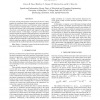Free Online Productivity Tools
i2Speak
i2Symbol
i2OCR
iTex2Img
iWeb2Print
iWeb2Shot
i2Type
iPdf2Split
iPdf2Merge
i2Bopomofo
i2Arabic
i2Style
i2Image
i2PDF
iLatex2Rtf
Sci2ools
ICASSP
2010
IEEE
2010
IEEE
Harmonic variable-size dictionary learning for music source separation
Dictionary learning through matrix factorization has become widely popular for performing music transcription and source separation. These methods learn a concise set of dictionary atoms which represent spectrograms of musical objects. However, there is no guarantee that the atoms learned will be perceptually meaningful, particularly when there exists significant spectral and temporal overlap among the musical sources. In this paper, we propose a novel dictionary learning method that imposes additional harmonic constraints upon the atoms of the learned dictionary while allowing the dictionary size to grow appropriately during the learning procedure. When there is significant spectral-temporal overlap among the musical sources, our method outperforms popular existing matrix factorization methods as measured by the recall and precision of learned dictionary atoms.
| Added | 06 Dec 2010 |
| Updated | 06 Dec 2010 |
| Type | Conference |
| Year | 2010 |
| Where | ICASSP |
| Authors | Steven K. Tjoa, Matthew C. Stamm, W. Sabrina Lin, K. J. Ray Liu |
Comments (0)

